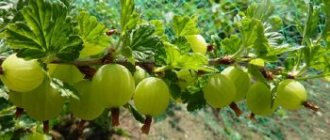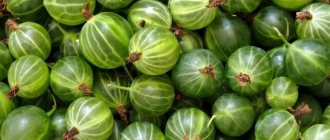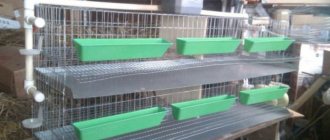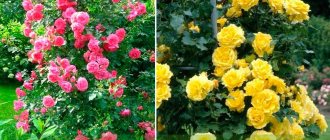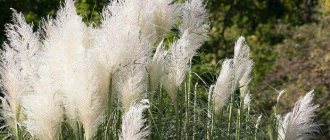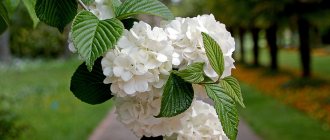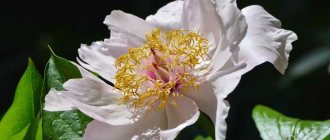| 13-06-2020 | 31 955
The blueberry is a cultivated version of its wild relative in the heather family, with larger, sweeter fruits. Today, blueberry seedlings populate private farmsteads and are even grown on an industrial scale. Varieties of this valuable berry are zoned for all agroclimatic zones of Belarus.
Planting blueberries +VIDEO
And we’ll start getting acquainted with the technology of growing blueberries, as always with planting.
Choosing a place, time and blueberry planting pattern
Blueberries do not really like drafts and windy open areas and grow and bear fruit much better in quiet areas, hidden from the prevailing winds by buildings or fences, but in well-lit areas.
Since blueberries are originally a wild berry, they can grow and bear fruit in partial shade, but the berry will be smaller in size and gain less sweetness compared to plants in full sunlight.
Blueberry seedlings with closed root
The best place on the site for planting blueberries will be quiet areas on the south side of buildings or fences.
Like any plant seedlings, blueberries are planted in autumn or early spring before sap flows and buds open in the plant. Preference is given to autumn planting, in which the seedling has time to adapt and take root in a new place in the fall, and immediately begins to grow in the spring. Seedlings with a closed root system (in containers with soil) can be planted throughout the growing season.
It is best to plant blueberries in rows, with a distance between plants of 1-1.5 m for tall varieties and 0.8-1 m for low-growing varieties. It is necessary to leave 2 or more meters between rows. With this planting scheme, plants receive the highest quality sunlight and, accordingly, grow and bear fruit well.
To illustrate the article here and below in the text, I bring to your attention the videos of Tatyana Kurlovich, a leading specialist at the National Academy of Sciences of Belarus:
Blueberry planting technique
Let's watch this wonderful video material by gardener N. Fursov, and then highlight the key points of planting blueberries: Key points of planting blueberries:
Soil composition for growing blueberries:
Propagation of blueberries by cuttings
The best time for cutting cuttings is the last ten days of June to the beginning of July inclusive, when annual growths have not yet become lignified. The event can be combined with thinning the blueberry bush. Cut off young branches that thicken the crown.
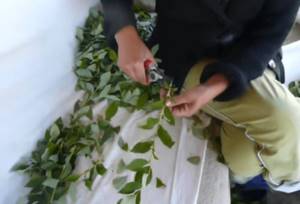
Annual semi-lignified twigs are used for cuttings
Remove the green tops of each shoot. Divide the rest into cuttings with 2-3 internodes. Cut off the bottom leaves entirely, leave only the top two and shorten them by half. The lower cut of the cutting should be sharp, with a bevel in the opposite direction from the growth of the lower leaf.
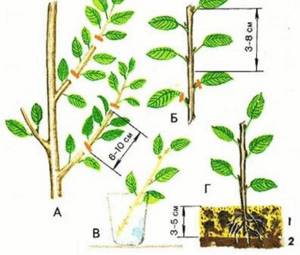
A - for cuttings, take the middle part of a side branch. B - the cut is made at an acute angle and not parallel to the growth of the bottom sheet. B - the cuttings are treated with a rooting agent. D - blueberry cuttings are planted in a loose and acidic substrate
The soil for blueberries should have an acidic pH of 4 to 5. Humus, compost, manure and even ordinary garden soil are contraindicated for this crop, since they have a slightly acidic and neutral reaction. The substrate can be composed of peat, river sand, pine litter and rotted sawdust in any proportions.
Before planting, keep each cutting in a root formation stimulator (Kornevin, Heterouxin, Epin, Ecogel and others). Plant in boxes in rows (5x10 cm) or in separate pots, deepening the cuttings halfway. Rooting should take place at high humidity and elevated temperature. Set up a mini-greenhouse or greenhouse. When young leaves begin to grow on the cuttings, the greenhouse can be ventilated, and after a week it can be removed completely. In the fall, a month before frost, transplant the strengthened seedlings to a permanent place.
Video: taking cuttings and planting
Pruning blueberries +VIDEO
Blueberries require regular annual pruning to maintain the vegetative green mass of the plant in optimal condition for growth and fruiting. Pruning is carried out, as on fruit trees, in early spring or late autumn before sap flows and buds begin to bloom on the plant or after natural leaf fall.
The first formative pruning of the plant is carried out in the third or fourth year of the bush’s life, and subsequently, after the bush enters fruiting, regulatory pruning is carried out annually. When the plant reaches 8-10 years old, anti-aging pruning is carried out.
Formative pruning is carried out on the plant to form the main skeletal branches of the bush and give the correct and convenient shape of its crown. For this purpose, only the most powerful, evenly and conveniently located shoots are selected. All weak, low and densely located shoots are removed.
Regulating and rejuvenating pruning aims to obtain evenly and well-spaced fruiting elements on the shoots - inflorescences and fruit buds. For this:
- Remove, as with formative pruning, all damaged, weak and inconveniently located shoots and branches.
- Large branches are kept in the bush for 5-6 years, and then removed at soil level, leaving no stumps.
- At the end of summer, pinch off the tops of strongly growing shoots.
- Bunches of small branches at the ends of the shoots are also removed.
Garden blueberries, cultivation and care +VIDEO
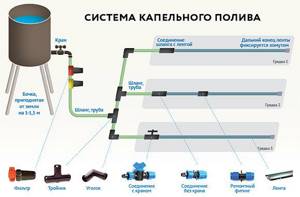
Blueberries are a very moisture-loving plant and require frequent watering in the absence of natural precipitation, this is especially true on light soils. The best results are obtained by planting with drip irrigation. Watering is carried out when the upper layers of soil dry out to a depth of more than 4-5 cm. Young plants and especially blueberry seedlings need 2-3 waterings per week in hot, dry weather. If the soil acidity is low, purchased soil acidifiers or 50-100 grams are added to the irrigation water once a month. table vinegar per bucket of water.
Mulching
A mandatory element of caring for this plant. It is best to mulch with coniferous wood sawdust or pine litter (needles that have fallen in the forest). These mulching materials not only retain moisture in the soil, but also acidify it when rotting.
Feeding and fertilizing blueberries.

These complex multicomponent fertilizers are designed specifically for this crop and contain all the nutrients necessary for blueberries.
A kilogram package is enough for a plantation of more than 30 square meters. meters. We also note that these fertilizers contain soil acidifiers
Fertilizer application time:
- The first application of fertilizer is in mid-April.
- Subsequent ones with an interval of 4-5 weeks.

N (nitrogen) promotes plant growth, but when applying fertilizers later than the second ten days of June, it will contribute to the continuous growth of the bush, which will contribute to freezing of individual branches or the entire bush in winter. Fertilizers are applied both in liquid form (dissolved in irrigation water) and in dry form, incorporating 2-5 cm into the soil around the tree trunk.
Prepare your own fertilizer for blueberries:
It is advisable to use sulfate fertilizers, as they slightly acidify the soil. Make a mixture of mineral fertilizers in the following proportions:
- ammonium sulfate - 90 grams.
- superphosphate - 110 grams.
- potassium sulfate - 40 grams. NOT potassium chloride!
- One level tablespoon contains approximately 8-10 grams. fertilizers, in a matchbox - 16-20 g.
The resulting mixture is applied to the soil around the plant trunk with the following dosage:
- Annual bush - 10 gr. (1 tablespoon without top).
- Two-year-old - 20 gr.
- Three-year-old - 30-40 gr.
- Four year old - 40-50 gr.
- From the age of five onwards - 60-80 g.
- On poor sandy soils, doses can be increased by 50%, and on rich chernozems, reduced accordingly.
Fertilizing is applied three times per season: the first in mid-April, subsequent ones with an interval of 4-5 weeks.
Blueberries from seeds
Propagation by seeds is a very interesting, but also labor-intensive method:
- You can buy seeds in a store in your city, order them online, or collect them yourself from berries, your own or purchased at the market.
- The soil is acidic peat, which can be mixed with coarse sand and rotted sawdust. Peat tablets are perfect.
- Sowing dates are easy to calculate. Stratification for blueberries lasts up to 90 days; it is advisable to obtain seedlings in March, when the sun begins to illuminate our windowsills well. Therefore, you need to start working with blueberry seeds in early December.
- Sowing is carried out superficially without deepening. Blueberry seeds are very small; the seedlings do not have enough strength to break through even loose soil. Moisten the substrate before sowing; if you water it after, the water will draw the seeds deeper. You can sow each seed in a seedling box in rows or individually in a peat tablet or cup.
- Cover the crops with glass or wrap them in a plastic bag and place them on the bottom shelf of the refrigerator for 3 months. Once a week you need to take it out, air it and, if necessary, moisten it.
- In March, transfer the crops to a bright and warm windowsill. After 1–3 weeks, shoots should appear. Grow them like regular seedlings. But do not forget to use special acidic soil from peat for picking without adding soil, humus and other components familiar to us.
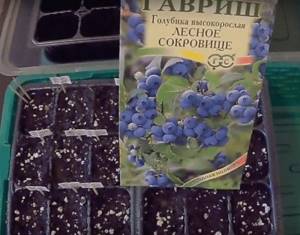
Blueberry seeds and loose substrate
Video: rules for stratification in the refrigerator and in the garden under the snow
The most popular varieties of blueberries
Bluecrop
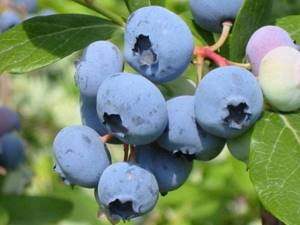
American blueberry variety Bluecrop. The variety has been known since 1952. The most valuable variety of highbush blueberry is the standard blueberry. The Bluecrop variety bush reaches a height of 1.6-1.9 meters. The bush is free-form, the shoots are directed upwards. The leaves are dark green, medium-sized, oblong, pointed in shape. The clusters are long. The berries are large, 17-20 millimeters in diameter, slightly flattened, blue, with a strong light blue bloom, elastic, very tasty, collected in small loose clusters. “Bluecrop” is a mid-season variety of blueberries (berry ripening: late July - August), ripening of berries is not simultaneous, fruiting is very abundant, regular, yield is 6 - 9 kg per bush. The berries are very tasty, both raw and processed. The fruits are suitable for home preparation and freezing. The berries do not crack, are well stored and transported. The blueberry variety Bluecrop is resistant to diseases and is not afraid of drought and frost. The bush can withstand frosts down to -34 °C, and flowers up to -7 °C. One of the most valuable blueberry varieties, suitable for both amateur cultivation and commercial purposes all over the world. Blueberry variety Bluecrop requires heavy pruning.
Patriot

Garden blueberry variety "Patriot" The garden blueberry variety "Patriot" was put into production in 1976. The height of the bush is 1.2–1.8 meters. The bush grows linearly and has an elongated shape. The bushes have an excellent decorative appearance. Fruit ripening time is mid-July. The berries of the “Patriot” variety are collected in dense clusters, but have different sizes and flattened shapes. The diameter of the berries is 17 - 19 millimeters. Berries that are not fully ripe have a characteristic red color. The berries of the "Patriot" variety are very tasty. It is recommended to eat them fresh. The highbush blueberry variety “Patriot” is winter-hardy and can withstand frosts down to -29 °C.
Bluetta
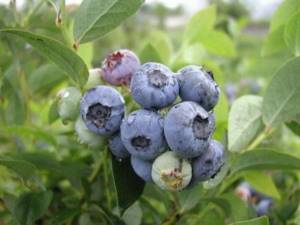
The Blewett blueberry variety was put into industrial production in 1967. The height of the bush is 0.9-1.2 meters. The bush is wide and squat. The berries ripen from the first ten days of July. The harvest is regular - 4.5-9 kilograms per bush. The size of the berry is 12-15 millimeters in diameter, with a wide ridge and dense pulp, dark blue in color. The berries of the Blueetta variety are very tasty. Blueberry variety Bluetta is recommended for fresh consumption. The Blueberry variety has high frost resistance and good decorative qualities.
Elizabeth
The bush of the Elizabeth garden blueberry variety is spreading, erect, reaching a height of 1.6 - 1.8 meters. The shoots have a characteristic red color, which indicates high winter hardiness. The Elizabeth highbush blueberry variety is easily propagated from woody cuttings. Fruiting is good, but slightly less than that of Bluecrop (4-6 kg per bush), spread over time, which will allow you to enjoy the beautiful berries for two weeks. The berries of the Elizabeth variety are quite large - 20-22 millimeters in diameter, strong, with a small scar, easily torn off and almost not deformed during long-term transportation. The fruit skin is beautiful, blue. The berries are very sweet and aromatic. In terms of taste, the Elizabeth variety is one of the best varieties. The berries begin to ripen in early August. Fruit clusters are very loose. Garden blueberry “Elizabeth” is a valuable late variety, despite the fact that part of the harvest may not always have time to ripen. The Elizabeth variety does not grow well in sandy soil, but does very well in soils with moderate peat content.
Northblue
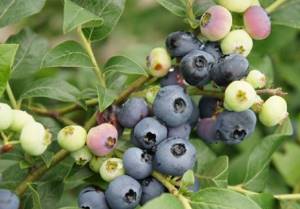
Low-growing blueberry variety "Northblue" The low-growing blueberry bush "Northblue" is powerful, reaching a height of 60-90 centimeters. The berries ripen from the beginning of August. The harvest of the "Norhblue" variety is good, regular - 1.2-2.5 kilograms per bush. The berries are large - 15-18 millimeters in diameter. Berry color: dark blue. The berries are dense, with a small scar and good taste. The berries keep well. The low-growing blueberry variety "Northblue" is recommended for fresh consumption and for industrial processing. The North Blue variety is highly frost-resistant and does not freeze at -35 °C. The North Blue variety bush has a good decorative appearance and can be used in landscape design.
In addition to the varieties listed above, mention should be made of blueberry varieties such as Duke, Jersey, Sunrise and many others.
Just a moment!
Gentlemen gardeners, our site is dedicated to the cultivation of grapes in northern regions that are unconventional for growing this crop, such as Belarus, the Baltic states, central Russia, Siberia...
If you are interested in the issue of growing grapes in these regions or have doubts about the very possibility of growing sunny berries in your conditions, welcome to the northern viticulture club using the links below...
Main page of the site
Error: Your requested Widget “WordPress Popular Posts” is not in the "Widgets for Shortcodes" sidebar
- [do_widget_area footer-1]
- [do_widget_area footer-2]
- [do_widget_area footer-3]
- [do_widget_area footer-4]
- [do_widget_area sidebar-1] [do_widget id="custom_html-3"]
- [d[do_widget id="wpp-2"]li>
- [do_[do_widget id="text-13"]>
Micropropagation of blueberries
Test tube seedlings are already appearing in our stores. In addition, the army of gardeners who know what meristems are and how plants develop from them is growing. Micropropagation is the growing of a seedling from a piece of tissue (meristem) of the mother plant. The apical meristems are mainly used. Their cells actively divide and lead to the continuous growth of leaves, stems, and flowers.
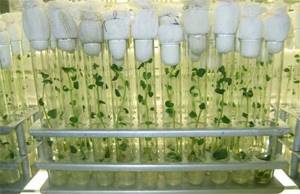
Plants were obtained microclonally - from a piece of tissue
For the average landowner, if it is possible to grow blueberries from cuttings or shoots, this method looks very illogical, complex and expensive. You will need laboratory equipment and a nutrient solution, specifically for this crop. It is also necessary to ensure optimal temperature conditions and sufficient lighting. After growing in vitro, the plants are acclimated to normal, non-sterile conditions.
However, this technology makes it possible to obtain thousands of seedlings from one branch, which are absolutely healthy and repeat all the properties of the mother plant. The artificial propagation method is actively spreading around the world; it is of interest to breeders and companies selling planting material.
Video: advantages of microclonal propagation and its main stages
Blueberries are considered a promising berry for business. In many countries it is grown on an industrial scale. For example, in Belarus the planting area is 500 hectares, and more than 100 farms are engaged in cultivation. Belarusian gardeners can buy both imported tall varieties and unique local ones, for example, with white fruits.
Video: blueberry cultivation in Belarus
Breeding blueberries is a promising activity. By purchasing 2–3 seedlings of different varieties, you can eventually grow an entire plantation of berries that are in high demand on the market. The most popular propagation methods are cuttings and layering, and large enterprises are adopting the microclonal method.
Every gardener dreams of harvesting a rich harvest of blueberries on their plot. This berry is becoming increasingly popular to grow, although it is not yet very common in gardens.
Many consumers appreciate blueberries for their excellent taste. But this berry, in addition to its rich taste, can offer the body many useful substances. Regular consumption of blueberries will help improve the functioning of the thyroid gland, heart, kidneys, and brain. Nutritionists have also noticed this magical berry for a long time: they recommend that everyone who needs to get their figure in order eats dishes that contain blueberries at least a couple of times a week.
Navigation for the article “Growing blueberries”

Whatever people called it! And if in botany textbooks everything is more or less clear - swamp blueberry, swamp blueberry or low-growing blueberry - then the population called it water drinker, gonobob, or even the somewhat strange names blueberry. And even worse - a fool. And these are not all of its names!
Ideal conditions for blueberry growth are in the Caucasus, as well as in the rocky and mossy tundra. This berry grows well in forest thickets and wetlands.
Blueberries will only be happy with a high-mountain climate and dry, rocky lands with acidic soil. Therefore, it is collected with pleasure by residents of Sweden, Norway and Iceland - these countries have everything this culture needs for good growth.

Blueberries are popular in the Far East: there they grow in large quantities and are taken for granted. For example, for representatives of local peoples - Koryaks, Nanais, Itelmens, who were born, raised and live in those parts - there is no problem finding fresh berries if you suddenly want to eat blueberries (or dunberry, as everyone calls it here) - as a rule, it grows right behind the fence.

